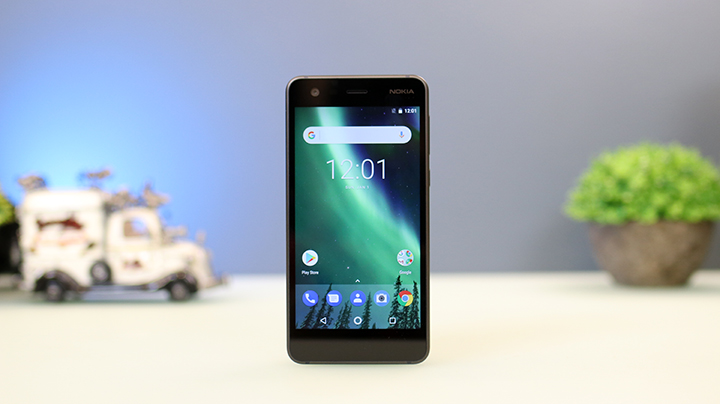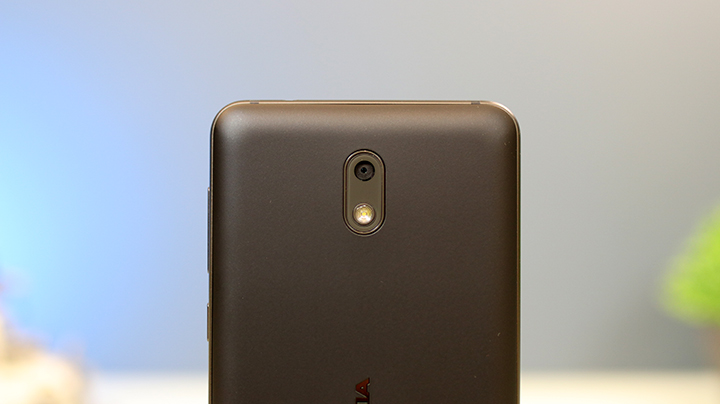HMD Global’s Nokia 2 is a Php5,290USD 90INR 7,642EUR 86CNY 656 device that sports modest specs — a 5-inch display, a Qualcomm Snapdragon Chip, and stock Android Nougat on board. Is it worth the price it asks for? Let’s find out in our full review of the company’s most affordable smartphone to land in the country yet.

Launched last February in the Philippines, the Nokia 2 presents itself with the same quality people have loved from the then Finnish-based phone manufacturer.
Table of Contents
As HMD Global revives the Nokia brand into a new global phenomenon with smartphones bearing pure Android, the device follows suit and the brand’s pristine aesthetic shows. Its design is similar to Nokia smartphones released in the past, sans the capacitive buttons below and thus left with a rather large bottom bezel.


At the front is the 5-inch display, a couple of sensors, the five-megapixel front camera, and the Nokia logo that’s just at the upper-right part beside the call speaker grille. These are all covered under Corning Gorilla Glass protection that also made navigation really fine and seamless.

The sides are all made of aluminum and done with a matte pewter finish that complements the overall color of the device. Looking at the right side, you can view and hold onto the power/lock button and the volume rockers. They’re placed rather higher than usual but is still reachable by one hand. The left side is kept clean.


Up top is the 3.5mm audio port for audio and a noise-canceling microphone, while the microUSB port and the microphone are right at the bottom. There are several antenna bands that are placed at these locations for better signal reception.

At the back of the device are the eight-megapixel camera with its accompanying LED flash that’s placed below, the Nokia logo in a vertically-placed orientation, and the loudspeaker grille. The matte black finish, though made of thin polycarbonate, repels most fingerprint smudges, not grease, and is actually attractive to look at. A small gap under the device opens the back to its internal components — there’s the non-removable 4,100mAh battery, two slots for nano-SIM cards, and a dedicated microSD card slot that supports up to 128GB of additional storage.
Overall, the Nokia 2 is a joy to hold despite bearing the extra heft due to the rather larger battery capacity and the metal chassis. The back plate seems sturdy but is quite thin that you’d break it if you are not careful upon prying it open. Gripping it is very comfortable, and one-hand operation is not a problem. The top and bottom bezels help when navigating the device in landscape mode.
The Nokia 2 sports a 5-inch IPS display with an HD resolution. It’s a decent screen packed with good contrast, great viewing angles, and decent color and sharpness as compared with other phones. It can detect up to 10 simultaneous touch points at a single time which should make it good for casual gaming. Sunlight legibility is decent at its best with the highest brightness, though you may still find a few instances of glare here and there during high noon. Likewise, the lowest brightness can be dealt with when reading stories at bedtime.

Its speaker is also decent at its best, it’s not really as spectacular as you would expect on a sub-Php6k smartphone. The volume’s good to be heard loudly at an average of 76dB, the loudspeaker’s quite distorted when set at the highest volume, and the included headphones are good but we’d recommend using your own pair if you’re not a fan of on-ear gear.

HMD Global’s most affordable Nokia has been equipped with an eight-megapixel shooter at the back and a five-megapixel selfie camera at the front. Both offer a few tricks under the sleeve such as HDR, panorama, and the company’s own version of Beautify mode which enhances your face with fairer skin rather than smoldering it with a brush of smoothing overlay.

The camera software offers guides such as a level, a compass, and a rule-of-thirds guideline overlay, along with a few watermarks. The switch camera button is quite hard to reach with one hand, requiring you to take full control of the device with your hands both on it. As for the rear camera, it takes decent shots that can be uploaded to social media with good colors and contrast.
The low-light and indoor shots are not something you’d want as they offer more noise than the usual, and detail may be a little soft to your liking. Focusing sometimes gets a bit too slow, and the images tend to get darker whenever you manually focus on the subject. Here are some sample shots:
The rear camera produces only 720p videos (an SoC limitation) and offer a rather unique experience with the auto-focus persistently checking on the subject as you move it. The details are low and soft as well. Here’s a sample clip:
If there is a thing that’s remarkable about the new Nokia phones, it would be the commitment of the company to stay behind an unforked, as-plain-as-you-get version of Android Nougat. You’re greeted with a launcher reminiscent to Google’s own Pixel line of devices, and several of the internet search mogul’s suite of apps. The Nokia Mobile Care (Support) and the Camera are also home-brewed and are pre-loaded right upon boot.

HMD Global has promised to update the device despite the entry-level internals and true enough, we have received two updates just as we booted the device. An upcoming Oreo update with Android Go modifications are said to be on the way, so we’d love to test this out again when it’s available.
All in all, there are only 4.45GB out of the device’s measly 8GB internal storage available for the user’s prerogative. There’s an expanded storage function via the microSD card, but the onboard storage itself may pose a problem in the long run if apps cannot be moved to the card.
Armed with a quad-core Qualcomm Snapdragon 212 chip and 1GB of RAM, the Nokia 2 performs quite well on basic tasks without the use of an internet connection, but lags for the most basic of search queries on Google Chrome once we use mobile data or internet via WiFi.

Adding to the factor that the device easily heats up its back part, you may encounter lags and hiccups when multitasking or even playing the most casual of games. We don’t recommend this to be a device you can play intensive games with, despite the rather large battery capacity to keep it up for longer periods of time. Here are our benchmarks:
AnTuTu – 25,345
GeekBench – 385 (Single-Core), 909 (Multi-Core)
PCMark – 3078 (Work)
3DMark – 0 (Slingshot)

Call quality is decent with the call speaker and is still audible in noisy environments. Other wireless connections such as Bluetooth, WiFi, and GPS work well, and the phone easily connects to 4G but is still location and signal-dependent.

The best feature this phone has is its battery. Rated at a 4100mAh capacity, the Nokia 2 was able to last for one and a half days of medium to heavy use including calls, camera, SMS, and internet browsing over WiFi and social media. The results of the phone’s benchmarks do not lie as well — it lasted 14 hours and 59 minutes with our PCMark Battery Test, while a video loop test of 50% brightness and zero volume in airplane mode brings a 19 hours and 33 minutes score. Recharging using the bundled 2A adapter takes around 2 hours which is quite decent, but we could’ve expected a faster one.
HMD Global strives to bring back Nokia’s glory days, and the Nokia 2 delivers for a good number of reasons. It is one of the company’s longest-lasting devices in terms of battery life, and it brings back what’s amiss to entry-level smartphones nowadays: great build and aesthetics with top-notch software and consistent updates. Add to that a good display and a dedicated microSD card slot, those are already good charms for an entry-level device when its contemporaries are not as frequent in updating their affordable smartphones and leave the user stuck with the same software all along.

The Php5,290USD 90INR 7,642EUR 86CNY 656 price tag placed on this smartphone seems pretty hefty, especially, for a device that offers low RAM and internal storage along with cameras that aren’t par with other devices that fall into this price range. With local and international brands thriving in this segment such as Cloudfone, Cherry Mobile, and even Huawei, the company may have a hard time convincing users to use a device with a rather sluggish performance when one can already buy better phones sporting at least 2GB of RAM and 16GB of internal storage.
Nonetheless, the Nokia 2 hits home where it wants to be. That’s to remind you that it’s here to stay, and a long-lasting one at that.
Nokia 2 specs:
5-inch LTPS HD display @ 1280 x 720 resolution, Gorilla Glass 3
1.3GHz Quad-Core Snapdragon 212
Adreno 304 GPU
1GB RAM
8GB Internal Storage
expandable via mircoSD up to 128GB
8MP Rear Camera with LED Flash
5MP Front Camera
4G VoLTE
Dual-SIM (nano), Dual Standby
microUSB
WiFi 802.11 b/g/n
Bluetooth 4.1
GPS
Android 7.1.1 Nougat (Android Oreo ready)
4,100mAh Battery
Copper Black, Pewter Black, Pewter White
What I liked about it:
– Premium build for an entry-level device
– Good display
– Good battery life
– dedicated microSD card slot
– Stock Android
What we didn’t like about it:
– low RAM and internal storage
– Cameras aren’t at par with contemporaries
– Expensive for its hardware

YugaTech.com is the largest and longest-running technology site in the Philippines. Originally established in October 2002, the site was transformed into a full-fledged technology platform in 2005.
How to transfer, withdraw money from PayPal to GCash
Prices of Starlink satellite in the Philippines
Install Google GBox to Huawei smartphones
Pag-IBIG MP2 online application
How to check PhilHealth contributions online
How to find your SIM card serial number
Globe, PLDT, Converge, Sky: Unli fiber internet plans compared
10 biggest games in the Google Play Store
LTO periodic medical exam for 10-year licenses
Netflix codes to unlock hidden TV shows, movies
Apple, Asus, Cherry Mobile, Huawei, LG, Nokia, Oppo, Samsung, Sony, Vivo, Xiaomi, Lenovo, Infinix Mobile, Pocophone, Honor, iPhone, OnePlus, Tecno, Realme, HTC, Gionee, Kata, IQ00, Redmi, Razer, CloudFone, Motorola, Panasonic, TCL, Wiko
Best Android smartphones between PHP 20,000 - 25,000
Smartphones under PHP 10,000 in the Philippines
Smartphones under PHP 12K Philippines
Best smartphones for kids under PHP 7,000
Smartphones under PHP 15,000 in the Philippines
Best Android smartphones between PHP 15,000 - 20,000
Smartphones under PHP 20,000 in the Philippines
Most affordable 5G phones in the Philippines under PHP 20K
5G smartphones in the Philippines under PHP 16K
Smartphone pricelist Philippines 2024
Smartphone pricelist Philippines 2023
Smartphone pricelist Philippines 2022
Smartphone pricelist Philippines 2021
Smartphone pricelist Philippines 2020
Android Peanut Butter says:
I don’t know about the low RAM, but if the phone is mostly stock Android experience without the OEM bloatware and tweaks, then chances are you can use the SD card as additional internal storage via the adopted storage feature that Google introduced if I remember correctly with Android Marshmallow. This is different from the usual method of using the SD card as a a removable storage medium similar to a floppy disk or USB flash disk. The “adopted” SD card becomes an integral, more or less permanent part of the system storage. The SD card, in fact, cannot be used in another cellphone, unless it is first reformatted, a security feature that some users might find annoying. However, Google also provides an option to format SD cards as traditional removable storage.
lol says:
Nokia 3 in lazada is only 5.3k with 2GB ram, 16GB rom and 8MP front&back cameras. Who will buy this expensive sht.
Audioslave says:
8gb Internal.. I cried.